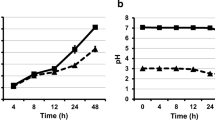Summary
Five haploid monokaryons of the basidiomycete Coprinus cinereus were already known to be unable to form sclerotia (asexual resting structures) on the vegetative monokaryotic mycelium. Genetic analyses had shown that four distinct genes (symbolised scl were represented, all being “recessive” to their sclerotium-producing alleles. In the study reported, homoallelic dikaryons were constructed and the effect of the sclerotium-negative genes on carpophore formation investigated. In the homoallelic state these defective genes prevent the formation of both sclerotia and carpophores by the dikaryon. Thereby demonstrating that these two structures share a common pathway of initiation. It is also shown that the expression of effects of scl genes on carpophore maturation in heteroallelic dikaryons is subject to the influence of modifying genes. Possible modes of action of modifying genes and of the scl genes are discussed and a carpophore developmental pathway is presented.
Similar content being viewed by others
References
Casselton LA, Lewis D (1967) Genet Res 9:63–71
Chang-Ho Y, Yee NT (1977) Trans Br Mycol Soc 68:167–172
Day PR (1963) Genet Res 4:323–325
Day PR, Anderson GE (1961) Genet Res 2:414–423
De Vries OMH, Hoge JHC, Wessels JGH (1980) Dev Biol 74:22–36
Esser K, Meinhardt F (1977) Mol Gen Genet 155:113–115
Esser K, Saleh F, Meinhardt F (1978) Current Genet 1:85–88
Hereward FV, Moore D (1979) J Gen Microbiol 113:13–18
Johnson TE (1978) Genetics 88:27–47
Lewis D, Vakeria D (1977) Genet Res 30:31–43
Matthews TR, Niederpruem DJ (1972) Arch Mikrobiol 87:257–268
Moore D (1967) Genet Res 9:331–342
Moore D, Elhiti MMY, Butler RD (1979) New Phytol 83:695–722
Moore D, Jirjis RI (1976) Trans Br Mycol Soc 66:377–382
Moore D, Jirjis RI (1981) New Phytol. 87:101–113
Moore D, Stewart GR (1972) J. Gen. Microbiol. 71:333–342
Senathirajah S, Lewis D (1975) Genet Res 25:95–107
Stahl U, Esser K (1976) Mol Gen Genet 148:183–197
Stewart GR, Moore D (1974) J Gen Microbiol 84:73–81
Swiezynski KM, Day PR (1960) Genet Res 1:114–128
Takemaru T, Kamada T (1972) Bot Mag 85:51–57
Waters H, Moore D, Butler RD (1975) New Phytol 74:207–213
Zantinge B, Dons H, Wessels JGH (1979) Eur J Biochem 101:251–260
Author information
Authors and Affiliations
Rights and permissions
About this article
Cite this article
Moore, D. Developmental genetics of Coprinus cinereus: Genetic evidence that carpophores and sclerotia share a common pathway of initiation. Current Genetics 3, 145–150 (1981). https://doi.org/10.1007/BF00365718
Received:
Revised:
Issue Date:
DOI: https://doi.org/10.1007/BF00365718




